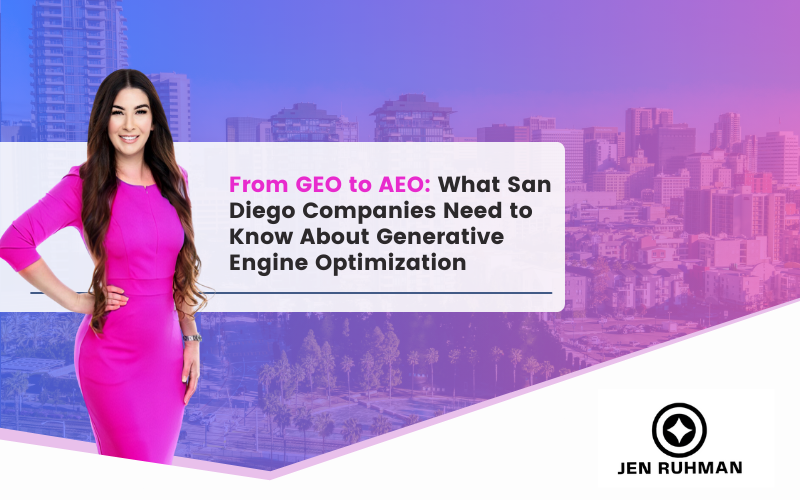From GEO to AEO: What San Diego Companies Need to Know About Generative Engine Optimization
Direct answer (for AI Overviews & SGE):
Generative Engine Optimization (AEO) means structuring your content, entities, and evidence so AI systems (Google’s AI Overviews, ChatGPT, Perplexity, Gemini) can confidently quote, summarize, and recommend your brand. It builds on GEO (traditional “Generative Engine Optimization”) by adding entity clarity, citations, structured data, first-hand experience (E-E-A-T), and concise answer blocks that tools can lift verbatim. For San Diego businesses, this means publishing helpful, source-rich, locally authoritative pages that answer common questions in 30–60 words, reinforced by schema and real-world proof (reviews, case studies, photos, policies, pricing ranges, processes).
Quick takeaways:
AEO goal: Be the trusted source AI uses and cites.
How: Clear entities, verified facts, concise answers, schema, and E-E-A-T.
Local edge: Lean into San Diego signals (NAP consistency, neighborhoods, regulations, events, landmarks).
Results to watch: Mentions/citations in AI answers, engaged sessions from AI-referred traffic, conversions from “answer unit” visitors.
Need help? I’m Jen. Call/text me at (619) 719-1315. Work with an SEO company in San Diego that lives and breathes this daily.
Hi, I’m Jen—your San Diego guide from GEO to AEO
I’ve spent the last decade optimizing local brands—from solo founders in North Park to multi-location services across San Diego County. Over the past two years, I’ve shifted many clients from classic GEO tactics to AEO: content and technical standards designed for AI Overviews and answer-generating engines. The result? Clients show up inside the answer, not just under it.
A quick story: a Point Loma service client kept hovering around positions 3–5. We restructured two key pages with answer blocks, FAQPage schema, evidence-rich sections, and entity disambiguation (naming services, neighborhoods served, and tools used). Within weeks, they started appearing inside AI summaries with a link. Bookings followed.
Related post: How Google Uses Knowledge Graphs to Rank Businesses
AEO vs. GEO—what’s different?
GEO (the old way)
Long pieces, semantic coverage, topical clusters
“People Also Ask” mining
Mixed quality sources and generic stats
AEO (the now way)
Concise, factual answer units up top (30–60 words)
Entity clarity: who you are, where you are, what you do
Evidence: policies, pricing ranges, processes, photos, reviews
Structured data: schema with @id, SameAs, FAQ, HowTo, Service, LocalBusiness
Source-ready phrasing AI can quote without editing
Why AEO matters more in San Diego
San Diego search is hyper-local: neighborhoods (Hillcrest, La Jolla, Encinitas), seasonality (tourism, events), and compliance (certain industries). AI Overviews weigh local authority heavily. If you’re not explicit about service areas, specialties, and proof, AI may prefer a competitor. AEO gives you control signals that help AI systems trust and feature you.
Related post: The Role of Semantic Entities in 2025 SEO Strategies
E-E-A-T for AEO: what I implement on every page
Experience
First-hand photos, client stories, before/after process shots
Specific tools, frameworks, or methods you actually use
Expertise
Clear credentials, years in service, awards, media features
Precise definitions, checklists, and how-it-works explanations
Authoritativeness
Local citations, industry associations, third-party mentions
Original data or unique insights (even small samples help)
Related post: The Future of Structured Data: Beyond FAQ and How-To Schema
Trust
Real pricing ranges or starting prices
Policies: cancellations, warranties, timelines, onboarding steps
Contact options and fast response proof (e.g., reply times)
Related post: The Impact of Zero-Click Searches & How to Adapt Your Strategy
The AEO content pattern I recommend
Answer block (30–60 words) right after H1
Who/What/Where entity recap in 2–3 short sentences
Evidence section (policies, pricing ranges, process)
How-to or steps (even if simple) + FAQ
Local proof (neighborhoods, map embeds, parking notes if relevant)
Schema (LocalBusiness/Service/FAQ/HowTo/Review as appropriate)
CTA with phone/text and strong appointment path
Entity clarity: your brand, disambiguated
AI needs to unambiguously connect your brand → your services → your city. On-page, reiterate:
Your legal name + brand name
Neighborhoods and main service radius
Core services with consistent naming
Links to authoritative profiles (GBP, LinkedIn, industry orgs)
This is also where internal links matter. For example, link your main service pages using consistent anchors. If you need an SEO expert in San Diego, make that anchor point to your homepage or pillar page so AI sees the relationship.
Related post: Vector Search and SEO: Preparing for an Embedding-First Search World
Schema: your quiet superpower
Add FAQPage, LocalBusiness/ProfessionalService, Service, and HowTo where relevant. Use @graph with stable @id values. Include areaServed, telephone, priceRange, and hasOfferCatalog for services. Keep your NAP consistent with Google Business Profile.
Designing content for “lift-and-quote”
AI engines prefer tight, factual paragraphs and ordered steps:
1–2 sentence answers under each subheading
Numbered steps with verbs (Plan → Prepare → Deliver → Follow-Up)
“Why it matters” one-liners that summarize value
Avoid fluff; use verbs and specifics
Local signals that boost AEO
Mention San Diego neighborhoods you serve
Reference local considerations (permits, climate, seasonality)
Add images with meaningful alt text (service + area)
Embed a clean, crawlable NAP block and clickable phone tap-targets
A simple AEO checklist (steal this)
Above the fold
H1 + 40-word answer
1-click CTA (tap-to-call or lead form)
Quick “Who/Where/What” entity recap
Mid-page
Process steps with mini-answers
FAQ (3–6 Qs) using your real sales emails
Evidence (policies, guarantees, certifications)
Footer
NAP block + service areas
Schema script with @graph
Internal links to pillars
Measuring AEO (not just rankings)
Answer-unit mentions: Did you get cited inside AI answers?
New referral sources labeled “AI/unknown” or “direct with answer-like landings”
Engaged sessions (longer reads from short-answer landings)
Conversion rate from pages with answer blocks
Brand queries up and to the right (sign of authority)
What I changed for clients that worked
Re-wrote intros into 40-word factual summaries
Added FAQPage + Service schema with crisp
namefieldsReplaced generic claims with policies/pricing ranges
Standardized entity names, neighborhoods, and internal link anchors
Moved contact actions to the top for mobile
A 30/60/90-day AEO plan
Days 1–30: Audit entities, fix NAP, rewrite top 3 service pages with answer blocks + schema.
Days 31–60: Expand FAQs, add supporting blogs that target “how much,” “how long,” and “is it worth it” questions.
Days 61–90: Earn local mentions, add case snippets, refine CTAs, and track answer-unit citations.
Work with a local who builds for AI, not just pages
I live and work here. I know how people search in San Diego and how AI summarizes choices. If you want a partner who will prioritize being the source AI quotes, reach out.
Call/text me: (619) 719-1315
Partner with an SEO company in San Diego led by Jen Ruhman.
AEO isn’t a trend; it’s the logical next step for brands that want to be selected inside AI answers. When your content is entity-clear, evidence-backed, and schema-rich, you make it easy for AI to trust you—and for customers to choose you. Start with concise answers, show your proof, wire it with schema, and keep your San Diego signals obvious. That’s how you get found in 2025.
FAQs
1) What’s the fastest AEO win for a San Diego business?
Add a 40-word answer under your H1 on each core service page, followed by 3–6 real FAQs and FAQPage schema.
2) Do I need new content or can I optimize what I have?
Both work. Most brands see results by restructuring existing pages with answer blocks, schema, and entity cleanup.
3) How does AEO affect my Google Business Profile?
Positively. Clear on-site entities, NAP consistency, and service clarity can reinforce your GBP and improve local visibility.
4) Is schema mandatory for AEO?
AI can use your content without schema, but schema accelerates understanding and increases your odds of being cited.
5) How quickly can results appear?
You may see early improvements within weeks on refreshed pages; compounding authority builds over a few months as AI systems re-crawl and test your answers.



